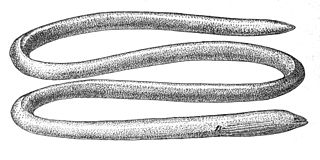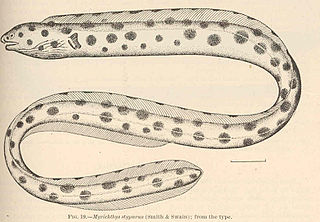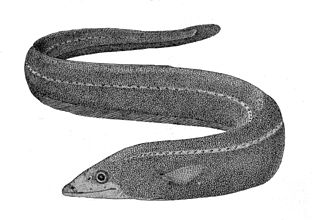
Pisodonophis is a genus of eels in the snake eel family Ophichthidae. It currently contains the following species:

The Java spaghetti eel, also known as the Java thrush-eel, Java worm eel, and the black-tailed thrush eel is an eel in the family Moringuidae. It was described by Johann Jakob Kaup in 1856, originally under the genus Aphthalmichthys. It is a tropical, marine eel which is known from the Indo-Pacific, including East Africa, the Tuamoto Islands, the Ryukyu Islands, and Micronesia. It is a burrowing species which inhabits reefs at a depth range of 2–15 m. Males can reach a maximum total length of 120 cm.
The purple spaghetti-eel is an eel in the family Moringuidae. It was described by Francis Buchanan-Hamilton in 1822, originally under the genus Muraena. It is a tropical eel known from India, Bangladesh, Nepal, Indonesia, and the Philippines. It inhabits rivers and estuaries, and has adapted to rapid and wide changes in salinity, pH, and osmoregulatory and hypoxic conditions. Males can reach a maximum standard length of 44 cm.

The Hawaiian garden eel is an eel in the family Congridae. It was described by John Ernest Randall and James Robert Chess in 1980. It is a marine, tropical eel which is known from the Hawaiian archipelago, in the eastern central Pacific Ocean. It is non-migratory, and is thought to be restricted to the region. It dwells at a depth range of 11 to 53 metres, and leads a benthic life, forming burrows in sand. Males can reach a maximum standard length of 59.8 centimetres (23.5 in).
The shortfinned worm eel is an eel in the family Ophichthidae. It was described by William John Macleay in 1881, originally under the genus Muraenichthys. It is a marine, temperate water-dwelling eel which is known from Australia, in the southwestern Pacific Ocean. It forms large colonies which inhabit burrows in soft sediments. Males can reach a maximum total length of 40 centimetres (16 in).
The Indo-Pacific slender worm-eel is an eel in the family Ophichthidae. It was described by Pieter Bleeker in 1857. It is a marine, tropical eel which is known from the Indo-Pacific, including the Red Sea, East Africa, the Line Islands, the Society Islands, Johnston Island, Japan, Rapa Iti, Micronesia, and the southern Great Barrier Reef. It forms burrows in inshore sediments of loose gravel and sand. Males can reach a maximum total length of 38 centimetres (15 in).
Brachysomophis atlanticus is an eel in the family Ophichthidae. It was described by Jacques Blache and Luiz Vieria Caldas Saldanha in 1972. It is a tropical, marine eel which is known from the eastern Atlantic Ocean, including Senegal and the Gulf of Guinea. It inhabits the continental shelf, and makes burrows in sand and mud. Males can reach a maximum total length of 27.3 centimetres.

The magnificent snake eel, also known as the Hawaiian spotted snake eel, is an eel in the family Ophichthidae. It was described by Charles Conrad Abbott in 1860, originally under the genus Pisodonophis. It is a marine, tropical eel which is known from the eastern central Pacific Ocean, including the Hawaiian Islands, the Leeward Islands, Johnston Island, and Midway Atoll. It dwells at a depth range of 1 to 262 metres, and inhabits crevices, sand and rocks. Males can reach a maximum total length of 78 centimetres (31 in).

The goldspotted eel, also known as the goldspotted snake eel or the dark-spotted snake eel, is an eel in the family Ophichthidae. It was described by Charles Alexandre Lesueur in 1825, originally under the genus Muraenophis. It is a marine, tropical eel which is known from the western and eastern Atlantic Ocean, including Bermuda, southern Florida, USA; the Bahamas, Santa Catarina, and Brazil. It dwells at a maximum depth of 15 metres (49 ft), and inhabits rocky and coral reefs. Males can reach a maximum total length of 110 centimetres (3.6 ft).

The dark-shouldered snake eel is an eel in the family Ophichthidae. It was described by Pieter Bleeker in 1864. It is a tropical, marine eel which is known from the Pacific Ocean, including the East Indies, the Society Islands, the Mariana Islands, Queensland, the Marshall Islands, Micronesia, Japan, and India. It dwells at a depth range of 2–15 metres, and inhabits reefs. It forms burrows in mud and sand, and forages during the night. Males can reach a maximum total length of 115 centimetres.

The rice-paddy eel is an eel in the family Ophichthidae. It was described by Francis Buchanan-Hamilton in 1822, originally in the genus Ophisurus. It is a tropical, marine eel which is known from the Indo-West Pacific, including Somalia, Tanzania, South Africa, India, Pakistan, Sri Lanka, Indonesia, Polynesia, Australia, Bangladesh, Cambodia, Kenya, Madagascar, the Philippines, Malaysia, Mozambique, Seychelles, Saudi Arabia, Taiwan, China, Thailand, Vietnam, and southern Yemen. It is an anadromous species and spawns in freshwater, often in rice paddies during the rainy season, earning it its common name. It also spends time in lagoons, estuaries and coastal rivers, in which it lives in burrows in the river bottom and bank. Males can reach a maximum total length (TL) of 100 centimetres, but more commonly reach a TL of 70 cm.

The longfin snake-eel is an eel in the family Ophichthidae. It was described by John Richardson in 1848. It has a Dorsal fin beginning above its pectoral fin with a snake-like upper body which is cylindrical, but compressed only along its extreme tail tip. It also has a tubular nostril in front and a nostril along lower edge of the lip in back. Colors range from grey to black to brown. Large longfin snake-eels have wrinkled skin.
Pisodonophis copelandi is an eel in the family Ophichthidae. It was described by Albert William Herre in 1953. It is a marine, tropical eel which is known from the Philippines, in the western central Pacific Ocean. Males can reach a maximum standard length of 30.8 centimetres (12.1 in).

The Marble-toothed snake-eel is an eel in the family Ophichthidae. It was described by Charles Henry Gilbert in 1898. It is a marine, tropical eel which is known from the eastern central and southeastern Pacific Ocean, including Costa Rica, Colombia, Panama and Ecuador. It dwells in shallow waters at a maximum depth of 10 metres (33 ft), and inhabits sand and mud sediments and mangroves. Males can reach a maximum total length of 68 centimetres (27 in).
Hoeven's snake eel is an eel in the family Ophichthidae. It was described by Pieter Bleeker in 1853, originally under the genus Ophisurus. It is a marine, tropical eel which is known from three specimens found in the Indo-Western Pacific, including Sulawesi, Indonesia, the Persian Gulf and the Gulf of Oman. It is known to inhabit shallow water and lagoons. Males are known to reach a total length of 22 centimetres (8.7 in).
The Korean snake eel is an eel in the family Ophichthidae. It was described by Hwan-Sung Ji and Jin-Koo Kim in 2011. It is a marine, temperate water-dwelling eel which is known from Korea, in the northwestern Pacific Ocean. It dwells at a depth range of 5 to 110 meters, and uses its hard, pointed tail to form burrows in sand and mud sediments. Females can reach a maximum total length of 60.1 centimeters (23.7 in).

Pisodonophis semicinctus is an eel in the family Ophichthidae. First described by John Richardson in 1848., it is a marine, subtropical eel which is known in the eastern Atlantic Ocean from Gibraltar to Angola. It was first recorded in the Mediterranean Sea in 1958 off Algeria and is now found on both shores of the western Basin. It dwells at a depth range of 10 to 30 m and inhabits the continental shelf, where it forms burrows in sand and mud. Males can reach a maximum total length of 80 cm, but more commonly reach a TL of 60 cm.

The Bean's sawtooth eel is an eel in the family Serrivomeridae. It was described by Theodore Gill and John Adam Ryder in 1883. It is a marine, deep water-dwelling eel which is known from throughout the Atlantic Ocean, the Indian Ocean, and the Western Pacific Ocean, including Iceland, South Africa, Réunion, and Australia. It dwells at a depth range of 0–5,998 metres (0–19,680 ft), and leads a solitary lifestyle. It migrates vertically at night. Males can reach a maximum total length of 78-80 centimetres, making it the largest sawtooth eel.

The shortdorsal cutthroat eel is an eel in the family Synaphobranchidae. It was described by Albert Günther in 1887. It is a marine, deep water-dwelling eel which is known from the Indo-Pacific and western central Atlantic Ocean, including Zanzibar, Maldives, Australia, Japan, Suriname, and the Gulf of Mexico. It dwells at a depth range of 900 to 3,000 metres, most often between 1,000 to 2,500 metres, and leads a benthic lifestyle, inhabiting the continental slope. Males can reach a maximum total length of 111 centimetres (44 in).

The Kaup's arrowtooth eel is an eel in the family Synaphobranchidae. It was described by James Yate Johnson in 1862. It is a marine, deep water-dwelling eel which is known from the Indo-Western Pacific and eastern and western Atlantic Ocean, including the Faroe Islands, Iceland, Cape Verde, the Western Sahara, Nigeria, Namibia, South Africa, Greenland, France, Saint Pierre and Miquelon, the United Kingdom, Ireland, the Philippines, Portugal, Spain, the Bahamas, Brazil, Canada, Cuba, Japan, Australia, Mauritania, Morocco, and Hawaii. It dwells at a depth range of 120 to 4,800 metres, most often between 400 and 2,200 metres, and inhabits the upper abyssal zone on the continental slope. It is intolerant of the temperatures of higher waters. Males can reach a maximum total length of 100 centimetres (39 in).











